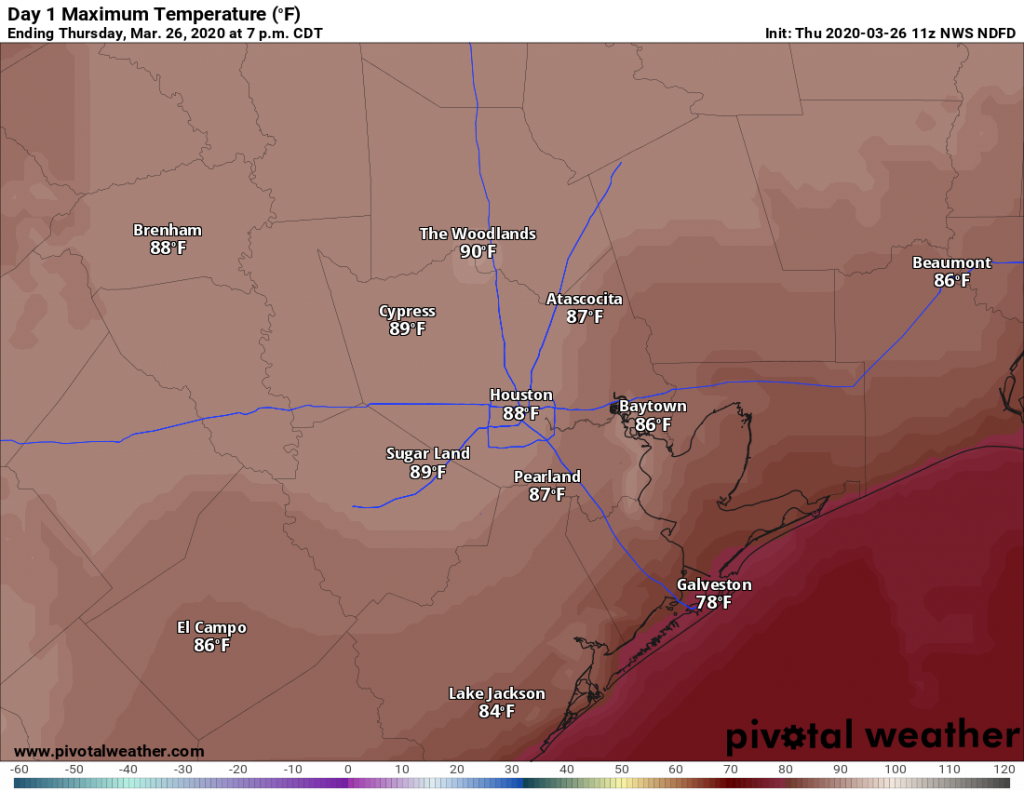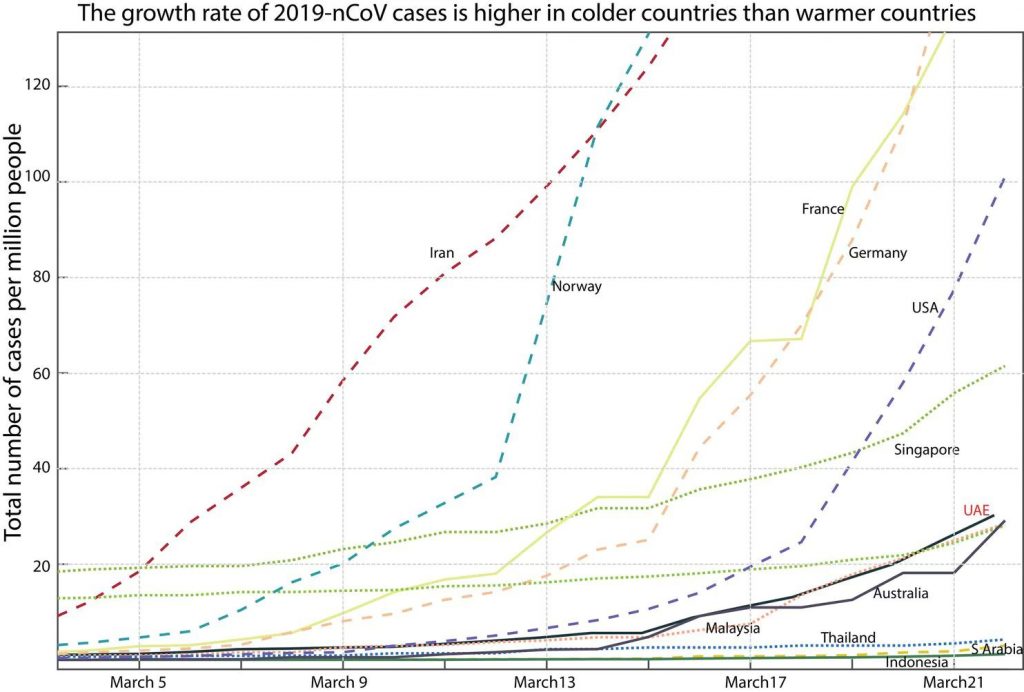Houston officially reached 90 degrees on Wednesday at Bush Intercontinental Airport, marking the region’s first such day of the year. This milestone has come about six weeks early this year, and we’ll see two more very warm March days before a cool front on Saturday. Speaking of the heat and humidity, we’ll address the idea that this may help to tamp down the local spread of Covid-19 at the end of this post. The short answer is that it’s possible, but the evidence is far from conclusive.
Thursday
This morning will start off mostly cloudy like Wednesday did, but we should see clearing skies by around noon, or shortly thereafter. Highs again should get up to near 90 degrees, with light winds, making for another very warm day. Lows tonight will likely only fall to around 70 degrees.

Friday
As high pressure begins to ease off, and some more clouds appear in the afternoon sky, temperatures Friday may hold in the mid- to upper-80s but the humidity will still be there. Winds will start to kick up during the afternoon or evening hours, gusting out of the south up to 20 mph.
Saturday
As we’ve been saying, conditions on Saturday will depend on the timing of the front, which probably will sweep through the area (beginning in the northwest) during the late morning hours and end up off the coast during the evening. Local highs will depend on the timing of the front. As for rain showers, most of the model guidance now shows something akin to a dying line of storms, so areas such as College Station may receive one-half inch of rain or more and a pretty good lightning show, with less as the showers get near Houston and push through the city. Lows Saturday night should drop into the 50s, except for the coast.
Sunday
This should be a pleasant, spring-like day with high temperatures in the upper 70s and mostly sunny skies.
Monday and beyond
The cold front returns onshore as a “warm” front, setting the stage for cloudier weather and highs of around 80 degrees for Monday and Tuesday. We’ll also see some decent rain chances, although at this point there’s no real signal for a soaker type event. A modest front pushes into the region some time around Wednesday, not too strong, but strong enough to bring some drier air and cooler nights.
Covid-19 and humidity
Most people are aware of the seasonal nature of influenza, which dies back during the warmer summer months in North America. Might we expect the same pattern with Covid-19? The short answer is that this is a big unknown, but we’re beginning to collect some evidence. A new statistical study authored last week suggests that warm and humid conditions may indeed help slow the spread of the virus, but the authors strongly cautioned that “effective public health interventions should be implemented across the world to slow down the transmission” of the disease. Based upon their analysis, the researchers estimated that 90 percent of disease transmissions through March 22, around the world, occurred in regions where the temperature was between 37 to 63 degrees, with an absolute humidity below 9g/m3. (Effectively, this is equivalent to a relative humidity of 40 percent at a temperature of 80 degrees Fahrenheit. This is well below typical late spring and summertime humidity in Houston). In a story by the Washington Post, multiple scientists cautioned that laboratory studies—which are beginning—are needed to confirm this behavior of the disease.

The bottom line is that there is some hope that warmer weather in Texas will help slow the spread of the disease here this summer. However, Louisiana has a similar climate, and is in the midst of what may soon become a crippling outbreak. Moreover, even if Covid-19 slows this summer, it is likely to come roaring back this fall as colder, drier weather returns to the region. So heat and humidity may be our ally, but for now social distancing and increased testing are our best weapons as we buy time for our medical community to study and treat the disease.

Singapore has a hot/humid climate and is also dealing with a massive COVID outbreak. Unfortunately warm weather is not going to be the solution to this pandemic…
Singapore has less than 1k cases and is an international hub in that region. If anything their ~700 cases proves the temperature/humidity slows the spread.
Social distancing! (not arguing with the points in the post but repeating it for the people in the back)
Compare MI vs OH
Blunt the curve before it starts and keep up the social distancing to keep it from spiking.
https://www.politico.com/interactives/2020/coronavirus-testing-by-state-chart-of-new-cases/
Heat will kill this off, but it needs to be much higher than 90 degrees. Part of the seasonality of virus transmission is people getting outside as the heat rises. Less people in movie theaters and malls, more outside. Virus’s transmit well indoors.
It seems this virus like crowded areas. I think Texas has a better chance just because we are not living on top of each other like New York City.
Ms. Morgan. I’m thinking the same. I was born in NYC. A city of 8 million that fits inside of an area the size of the 610 loop. That is a tight nook and cranny to live in. Our city is one of the heavyweights in terms of large population centers along with L.A , Chicago, and Miami. I’m just a layman theorizing that our sprawl may help put a cap on runaway cases here. Time will tell.
I subscribe to this theory. I was born in NYC, a population of 8 million people that fits inside of an area the size of loop 610. That is one tight nook and cranny to live in. Houston is one of the heavyweight population centers and international travel hubs along with L.A , Chicago, Miami. Our sprawl may put a cap on runaway cases here.
I’m just a layman theorizing here. Time will tell.
I was born in New York. Population of 8 million in an area the size of loop 610. That is one tight crevice to live in.
Houston is one of the heavyweight population and international travel hubs along with L.A., Chicago and Miami. I’m with you Blackhawk. Houston’s sprawl may put a cap on runaway cases here.
Time will tell.
Heat and humidity might have an effect, except for air conditioning.
I’m not running the A/C during most of the day. I’m airing out the house overnight and then letting the inside temp hit 80 by afternoon. I have a very well insulated home including low E windows. Just in case there is something to the warm and humid thing.
There is something to be said for letting fresh air into your home. I read an article that said some of the most effective treatment methods for the 1918-19 Spanish Flu epidemic (ironic name, given that it likely originated in Kansas and was carried by Yanks to the Great War, but I digress) involved treating patients outdoors, rather than in crowded and enclosed spaces. Letting the outside in I suspect will give you multiple benefits.
I ran some calcs yesterday in Excel which showed some interesting stats:
As of yesterday, Harris county has a confirmed infection rate of 36 people per million (PPM).
This is 17% of the national rate of 210 PPM, 76% of the Texas rate of 47 PPM, and 1.4% of the New York City rate 2411 PPM. Does this really mean it’s not as wide-spread here, or is the level of testing in Harris County even worse than we thought?
The City of Houston has a population density between 1/7th and 1/8th that of New York City. I think that’s huge given both cities are international travel hubs. New York City has a lot of travel to and from places like Italy, but Houston has a lot of travel to and from Asia and the Middle East.
I’ll be in a teleconference tonight which includes a professor at one of the medical schools here, so tomorrow I’ll post anything important I learn.
Lizzie Fletcher’s teleconference?
No – Church Session telecon about where to go from here for possibly how long.
There are a lot of interesting questions. The virus arrived in the US in mid-January, it couldn’t have gotten to Italy much earlier than that, how come Italy was swamped, but the US wasn’t overrun at the same time as Italy?
The cultures of Asia are different. To a lot of Asian cultures the US is already socially distant. In Japan, there are oshiya who push people into the subway cars, in order to pack them in. In Italy, multi generational households are the norm. Italians also like to kiss and hug a lot. Just many factors that make me wonder about why the virus seems to act differently in different climates and countries.
Italy is the second oldest country on earth. Only Japan has an older population. The Lombard region – where this took off – is the oldest part of Italy. Italy has a good deal of travel to and from China and Iran, another ravaged country. As you mentioned social kissing is common in not only Italy but also in Spain (ditto).
I believe the Lombard region also had a direct business connection with Wuhan including routine flights.
While it is hopeful that the heat and humidity may cut down the virus, physical distancing and staying at home is the current best tools we have.
Let’s not forget that staying home means the hospitals are not overloaded. And, physical distancing slows the transmission. Both are needed and to be sustained.
I am fearful that, as each week passes, people will get cabin fever and let down their guard. There was a good article on NPR about how various US cities fared during the 1918 Spanish flu pandemic showing how early shutdowns helped but a relaxation of restrictions caused a second spike.
You may think it is hard to stay at home – but it just may save you from being hospitalized. Bored? Take a nap. Call a friend. Try a new recipe. Clean out that garage. Recaulk that tub. Clean out that dryer lint filter.
I definitely think heat and humidity are a big factor. Just seems like the worst hit areas all had cool weather. Northern Italy but not southern Italy as much. Same with the US and areas in China and Spain. Louisiana is the exception but you’re seeing the delayed effects of Mardi Gras 2 weeks ago and when it was cooler. If their cases continue to skyrocket over the next couple weeks then we’ll know, it’s not as much of a factor…and we’ll also need to shut down I-10 at the Sabine River 🙂
Also, the poverty and health care system in Louisiana aren’t helping much.
As always, we appreciate having Space City Weather when things get crazy. You’re a solid source of comfort.